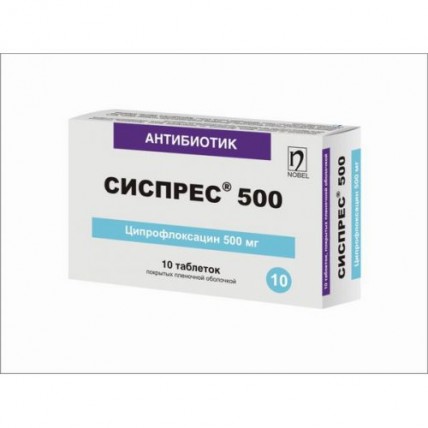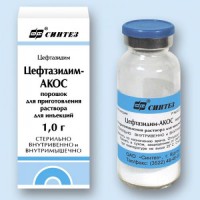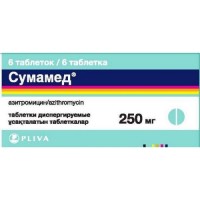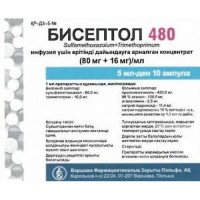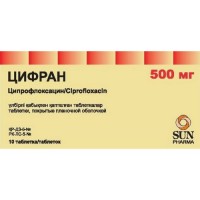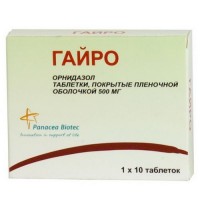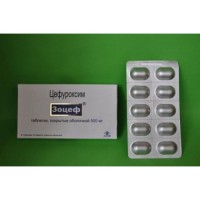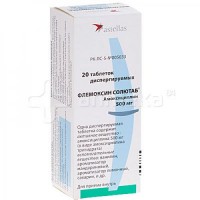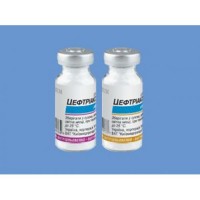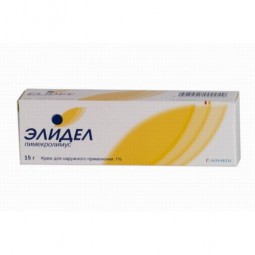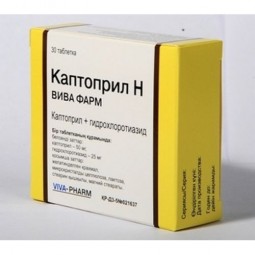Sispres 10s 500 mg coated tablets
- $8.80
The instruction for use
of medicine for experts
Сиспрес® 250 Сиспрес® 500 Сиспрес® 750
Trade name
Сиспрес® 250 Сиспрес® 500 Сиспрес® 750
International unlicensed
names Ciprofloxacin Dosage Form
of the Tablet, film coated, 250 mg or 500 mg or 750 mg
Structure
One tablet contains
active agent – ciprofloxacin the hydrochloride of 291.51 mg, 583.00 mg,
874.50 mg equivalent to 250 mg, 500 mg, 750 mg of ciprofloxacin
respectively,
excipients: corn starch, cellulose microcrystalline PH 102, magnesium stearate, aerosil 200, PVP K 30 polyvinylpirrolidone, sodium of a kroskarmelloz,
structure of a cover: a gipromeloza, the titan dioxide, polyethyleneglycol
the Description
Сиспрес® 250 – tablets, film coated white color
with a biconvex surface, round shape
Сиспрес® 500 - tablets, film coated white color
with a biconvex surface, oblong shape, with risky
Сиспрес® 750 - tablets, film coated white color
with a biconvex surface, oblong shape
Pharmacotherapeutic group
Antibacterial drugs – derivatives of a hinolon. Ftorkhinolona.
The code of automatic telephone exchange J01MA02
the Pharmacological
Pharmacokinetics Drug properties after oral administration is quickly and well absorbed from the digestive tract (DT). The bioavailability is 50-85%, the maximum concentration of drug in blood is reached within 0.5-2.5 hours. Ciprofloxacin for 16-43% contacts proteins of blood plasma.
After reception, ciprofloxacin is widely distributed in fabrics and liquids of an organism. High concentrations of drug are observed in tonsils, lungs, kidneys, a liver, bile and a gall bladder, semen, fabrics of a prostate and its secret, endometrium, fallopian pipes and ovaries. Elimination half-life of ciprofloxacin at adults with normally functioning kidneys makes 3-5 hours of plasma. Drug is partially metabolized in a liver with formation of 4 metabolites: diethylciprofloxacin, sulfociprofloxacin, oxociprofloxacin, N-formiltsiprofloksatsin.
Ciprofloxacin and its metabolites are removed from an organism with urine (50-70%) and a stake (15-30%). Not changed ciprofloxacin is emitted with urine, by means of glomerular filtration and canalicular secretion. At oral administration of a therapeutic dose of 15% - 50% of a dose are removed with urine within 5 days.
The pharmacodynamics
of Sispres® is microbicide. As other ftorkhinolonovy antibacterial substances, ciprofloxacin are inhibited by DNA-topoisomerase (DNK-girazu) of a microorganism, susceptible to drug. DNK-giraza it is necessary for a reproduction and some moments of a transcription, restoration, a recombination and transposition of bacterial DNA. A target of ciprofloxacin is the enzyme A-subunit. Ciprofloxacin can also interact with B-subunits of enzymes.
Сиспрес® has a broad spectrum of activity and it is highly active against the majority of gram-negative aerobic bacteria, including Enterobacteriaceae and Pseudomonas aeruginosa, Escherichia coli, Shigella, Salmonella, Citrobacter, Klebsiella, Enterobacter, Serratia, Hafnia, Edwardsiella, Proteus, Providencia, Morganella, Yersinia, Vibrio, Aeromonas, Plesiomonas, Pasteurella, Haemophilus, Gardnerella, Campylobacter, Pseudomonas, Logionella, Neisseria, Moraxella, Acinebacter, Flavobacterium, Alcaligenes, Brucella.
Сиспрес® it is also active against many gram-positive aerobic bacteria, including Staphylococcus aureus, koagulozo-negative strains of staphylococcus, Steptococcus pyogenes, Streprococcus pneumoniae, Listeria, Corynebacterium.
Сиспрес® it is active against the bacteria producing beta lactamazu.
Сиспрес® influences obligate anaerobic bacteria, such as Bacteroides, Fusobacterium Peptococcus, Clostridium, Eubacterium, Actinomyces veilonella a little.
Сиспрес®, tablets, film coated, are also active against Chlamydia, Mycoplasma, Micobacterium. Drug is less active against anaerobic bacteria, such as Ureaplasma and some strains of mycobacteria.
Indications
the infectious and inflammatory diseases Caused by microorganisms, sensitive to drug,
- ENT organs
- respiratory bodies
- intestinal infections (salmonellosis, a shigellosis, cholera)
- a typhoid
- urinogenital bodies
- skin and soft tissues
- a bone articulate system
- an infection, sexually transmitted
- a septicaemia
- diseases and injuries of organs of sight
- postoperative complications
- prevention and treatments of infections at people with reduced immunity
the Route of administration and doses
it is necessary to take the Drug on an empty stomach, washing down with enough liquid.
The recommended dose for adults in infectious and inflammatory diseases of an urinogenital system makes 250-500 mg each 12 hours.
In infections of other localization the recommended dose makes 500-750 mg each 12 hours.
For the majority of infectious and inflammatory diseases the treatment has to continue at least 48 hours, after disappearance of symptoms. On average, the course of treatment makes 10 days.
In case the clearance of creatinine is 20 ml a minute or less, patients can receive a half of the recommended dosage.
The maximum single dose of drug - 750 mg, daily - 1500 mg.
Side effects
- nausea, vomiting, diarrhea, an abdominal pain, increase in activity of alaninaminotranspherase, aspartate aminotransferase, a lactate dehydrogenase, alkaline phosphatase, bilirubin
- a headache, dizziness, feeling of fatigue, sleep disorder, hallucinations, faints, disorders of vision
- a crystalluria, an albuminuria, a hamaturia, a dysuria, a polyuria, passing increase in creatinine of blood
- an eosinophilia, a leukopenia, a neutropenia, thrombocytopenia
- tachycardia, disturbances of a rhythm, arterial hypotension
- a skin itching, a small tortoiseshell, a Quincke's edema, arthralgias, Stephens-Johnson's syndrome
- candidiasis of mucous membranes
of the Contraindication
- hypersensitivity to ciprofloxacin or other drugs from group of ftorkhinolon
- epilepsy
- pregnancy and a lactation
- children's and teenage age up to 18 years
Medicinal interactions
the Accompanying intake of aminoglycosides or beta laktamnykh antibiotics can cause additional or synergy effects.
At simultaneous use with warfarin the risk of bleeding increases.
Joint intake of ciprofloxacin with didanoziny reduces ciprofloxacin absorption, owing to formation of complexes of ciprofloxacin with the aluminum, magnesian salts which are contained in the didanozena.
The concomitant use of ciprofloxacin with theophylline can lead to increase in plasma concentration of theophylline and extension of its elimination half-life.
Probenetsid interferes with renal secretion of ciprofloxacin and promotes increase in level of ciprofloxacin in blood.
Reception of the antacids and drugs containing ions of iron, zinc, aluminum, magnesium reduces ciprofloxacin absorption therefore the interval between intake of these drugs has to make not less than 4 hours.
At simultaneous use of ciprofloxacin and cyclosporine the nephrotoxic effect of cyclosporine amplifies.
Non-steroidal anti-inflammatory drugs (except for acetylsalicylic acid) increase risk of developing spasms.
Special instructions
during drug treatment the consumption of enough liquid is necessary for prevention of a crystalluria.
With care it is necessary to apply at patients with atherosclerosis of vessels, disturbance of cerebral circulation, a convulsive syndrome.
The feature of influence of medicine on ability to run the vehicle or potentially dangerous mechanisms
needs to be careful during the driving of the car and occupations other potentially dangerous types of activity requiring special attention and speed of psychomotor reactions.
Overdose
Data on overdose of drug are absent. Treatment: specific antidote is unknown. It is necessary to control carefully a condition of the patient, to make gastric lavage, to carry out usual measures of emergency aid, to provide sufficient intake of liquid. By means of haemo - or peritoneal dialysis the amount of drug can be removed only insignificant (less than 10%).
Form of release and packing
of the Tablet, film coated, 250 mg, 500 mg or 750 mg.
Primary packing – the blisters containing 10 or 14 tablets Сиспрес® 250 and 5 or 7 of tablets Сиспрес® 500 or Сиспрес® 750.
Secondary packing - the cardboard pack containing 1 Сиспрес® 250 or 2 blister of the Сиспрес® 500 or 2 blister of the Сиспрес® 750 blister together with the instruction for use of medicine.
To Store storage conditions at a temperature not above 25 °C in the dry, protected from light place.
To store out of children's reach!
A period of storage
2 years
not to apply after an expiration date
Prescription status
According to the prescription
Republic of Kazakhstan JSC Nobel Almatinskaya Pharmatsevticheskaya Fabrika Producer
Almaty, Shevchenko St., 162 E.
To develop
of medicine for experts
Сиспрес® 250 Сиспрес® 500 Сиспрес® 750
Trade name
Сиспрес® 250 Сиспрес® 500 Сиспрес® 750
International unlicensed
names Ciprofloxacin Dosage Form
of the Tablet, film coated, 250 mg or 500 mg or 750 mg
Structure
One tablet contains
active agent – ciprofloxacin the hydrochloride of 291.51 mg, 583.00 mg,
874.50 mg equivalent to 250 mg, 500 mg, 750 mg of ciprofloxacin
respectively,
excipients: corn starch, cellulose microcrystalline PH 102, magnesium stearate, aerosil 200, PVP K 30 polyvinylpirrolidone, sodium of a kroskarmelloz,
structure of a cover: a gipromeloza, the titan dioxide, polyethyleneglycol
the Description
Сиспрес® 250 – tablets, film coated white color
with a biconvex surface, round shape
Сиспрес® 500 - tablets, film coated white color
with a biconvex surface, oblong shape, with risky
Сиспрес® 750 - tablets, film coated white color
with a biconvex surface, oblong shape
Pharmacotherapeutic group
Antibacterial drugs – derivatives of a hinolon. Ftorkhinolona.
The code of automatic telephone exchange J01MA02
the Pharmacological
Pharmacokinetics Drug properties after oral administration is quickly and well absorbed from the digestive tract (DT). The bioavailability is 50-85%, the maximum concentration of drug in blood is reached within 0.5-2.5 hours. Ciprofloxacin for 16-43% contacts proteins of blood plasma.
After reception, ciprofloxacin is widely distributed in fabrics and liquids of an organism. High concentrations of drug are observed in tonsils, lungs, kidneys, a liver, bile and a gall bladder, semen, fabrics of a prostate and its secret, endometrium, fallopian pipes and ovaries. Elimination half-life of ciprofloxacin at adults with normally functioning kidneys makes 3-5 hours of plasma. Drug is partially metabolized in a liver with formation of 4 metabolites: diethylciprofloxacin, sulfociprofloxacin, oxociprofloxacin, N-formiltsiprofloksatsin.
Ciprofloxacin and its metabolites are removed from an organism with urine (50-70%) and a stake (15-30%). Not changed ciprofloxacin is emitted with urine, by means of glomerular filtration and canalicular secretion. At oral administration of a therapeutic dose of 15% - 50% of a dose are removed with urine within 5 days.
The pharmacodynamics
of Sispres® is microbicide. As other ftorkhinolonovy antibacterial substances, ciprofloxacin are inhibited by DNA-topoisomerase (DNK-girazu) of a microorganism, susceptible to drug. DNK-giraza it is necessary for a reproduction and some moments of a transcription, restoration, a recombination and transposition of bacterial DNA. A target of ciprofloxacin is the enzyme A-subunit. Ciprofloxacin can also interact with B-subunits of enzymes.
Сиспрес® has a broad spectrum of activity and it is highly active against the majority of gram-negative aerobic bacteria, including Enterobacteriaceae and Pseudomonas aeruginosa, Escherichia coli, Shigella, Salmonella, Citrobacter, Klebsiella, Enterobacter, Serratia, Hafnia, Edwardsiella, Proteus, Providencia, Morganella, Yersinia, Vibrio, Aeromonas, Plesiomonas, Pasteurella, Haemophilus, Gardnerella, Campylobacter, Pseudomonas, Logionella, Neisseria, Moraxella, Acinebacter, Flavobacterium, Alcaligenes, Brucella.
Сиспрес® it is also active against many gram-positive aerobic bacteria, including Staphylococcus aureus, koagulozo-negative strains of staphylococcus, Steptococcus pyogenes, Streprococcus pneumoniae, Listeria, Corynebacterium.
Сиспрес® it is active against the bacteria producing beta lactamazu.
Сиспрес® influences obligate anaerobic bacteria, such as Bacteroides, Fusobacterium Peptococcus, Clostridium, Eubacterium, Actinomyces veilonella a little.
Сиспрес®, tablets, film coated, are also active against Chlamydia, Mycoplasma, Micobacterium. Drug is less active against anaerobic bacteria, such as Ureaplasma and some strains of mycobacteria.
Indications
the infectious and inflammatory diseases Caused by microorganisms, sensitive to drug,
- ENT organs
- respiratory bodies
- intestinal infections (salmonellosis, a shigellosis, cholera)
- a typhoid
- urinogenital bodies
- skin and soft tissues
- a bone articulate system
- an infection, sexually transmitted
- a septicaemia
- diseases and injuries of organs of sight
- postoperative complications
- prevention and treatments of infections at people with reduced immunity
the Route of administration and doses
it is necessary to take the Drug on an empty stomach, washing down with enough liquid.
The recommended dose for adults in infectious and inflammatory diseases of an urinogenital system makes 250-500 mg each 12 hours.
In infections of other localization the recommended dose makes 500-750 mg each 12 hours.
For the majority of infectious and inflammatory diseases the treatment has to continue at least 48 hours, after disappearance of symptoms. On average, the course of treatment makes 10 days.
In case the clearance of creatinine is 20 ml a minute or less, patients can receive a half of the recommended dosage.
The maximum single dose of drug - 750 mg, daily - 1500 mg.
Side effects
- nausea, vomiting, diarrhea, an abdominal pain, increase in activity of alaninaminotranspherase, aspartate aminotransferase, a lactate dehydrogenase, alkaline phosphatase, bilirubin
- a headache, dizziness, feeling of fatigue, sleep disorder, hallucinations, faints, disorders of vision
- a crystalluria, an albuminuria, a hamaturia, a dysuria, a polyuria, passing increase in creatinine of blood
- an eosinophilia, a leukopenia, a neutropenia, thrombocytopenia
- tachycardia, disturbances of a rhythm, arterial hypotension
- a skin itching, a small tortoiseshell, a Quincke's edema, arthralgias, Stephens-Johnson's syndrome
- candidiasis of mucous membranes
of the Contraindication
- hypersensitivity to ciprofloxacin or other drugs from group of ftorkhinolon
- epilepsy
- pregnancy and a lactation
- children's and teenage age up to 18 years
Medicinal interactions
the Accompanying intake of aminoglycosides or beta laktamnykh antibiotics can cause additional or synergy effects.
At simultaneous use with warfarin the risk of bleeding increases.
Joint intake of ciprofloxacin with didanoziny reduces ciprofloxacin absorption, owing to formation of complexes of ciprofloxacin with the aluminum, magnesian salts which are contained in the didanozena.
The concomitant use of ciprofloxacin with theophylline can lead to increase in plasma concentration of theophylline and extension of its elimination half-life.
Probenetsid interferes with renal secretion of ciprofloxacin and promotes increase in level of ciprofloxacin in blood.
Reception of the antacids and drugs containing ions of iron, zinc, aluminum, magnesium reduces ciprofloxacin absorption therefore the interval between intake of these drugs has to make not less than 4 hours.
At simultaneous use of ciprofloxacin and cyclosporine the nephrotoxic effect of cyclosporine amplifies.
Non-steroidal anti-inflammatory drugs (except for acetylsalicylic acid) increase risk of developing spasms.
Special instructions
during drug treatment the consumption of enough liquid is necessary for prevention of a crystalluria.
With care it is necessary to apply at patients with atherosclerosis of vessels, disturbance of cerebral circulation, a convulsive syndrome.
The feature of influence of medicine on ability to run the vehicle or potentially dangerous mechanisms
needs to be careful during the driving of the car and occupations other potentially dangerous types of activity requiring special attention and speed of psychomotor reactions.
Overdose
Data on overdose of drug are absent. Treatment: specific antidote is unknown. It is necessary to control carefully a condition of the patient, to make gastric lavage, to carry out usual measures of emergency aid, to provide sufficient intake of liquid. By means of haemo - or peritoneal dialysis the amount of drug can be removed only insignificant (less than 10%).
Form of release and packing
of the Tablet, film coated, 250 mg, 500 mg or 750 mg.
Primary packing – the blisters containing 10 or 14 tablets Сиспрес® 250 and 5 or 7 of tablets Сиспрес® 500 or Сиспрес® 750.
Secondary packing - the cardboard pack containing 1 Сиспрес® 250 or 2 blister of the Сиспрес® 500 or 2 blister of the Сиспрес® 750 blister together with the instruction for use of medicine.
To Store storage conditions at a temperature not above 25 °C in the dry, protected from light place.
To store out of children's reach!
A period of storage
2 years
not to apply after an expiration date
Prescription status
According to the prescription
Republic of Kazakhstan JSC Nobel Almatinskaya Pharmatsevticheskaya Fabrika Producer
Almaty, Shevchenko St., 162 E.
To develop
